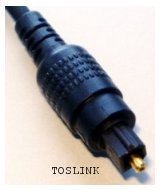

Standard 5.1 Encoding
Most 5.1 Surround is compressed in either a lossy or lossless format. For DVDs the Dolby Digital format is mandatory (must be supported by all players), while DTS support is optional. Both are lossy formats. For DVD-Audio either uncompressed LPCM or losslessly compressed Meridian Lossless Packing (MLP) may be used. HD DVD and Blu-ray both include Dolby Digital and DTS as mandatory formats. HD DVD also makes (Dolby Digital Plus, a high Bitrate lossy format) and Dolby TrueHD (an improved version of MLP) mandatory, while they're optional for Blu-ray. Both Blu-ray and HD DVD include DTS-HD, which is another lossless format, as optional.
5.1 Surround Connections
Depending on the type of 5.1 Surround signal you need to get from a source, such as a DVD player or Set-Top Box, to a home theater receiver or other processing device (such as a computer) there are a number of possible of connection standards.
 S/PDIF
S/PDIF
S/PDIF, or Sony/Panasonic Digital Interface, is a standard for transmitting digital audio between consumer electronics components. It can also be used for connections to or from a computer. S/PDIF connections can use either coaxial cable with RCA connectors or TOSLINK fiber optic cables.
 Due to the relatively low throughput of S/PDIF, uncompressed or losslessly compressed 5.1 Surround signals can't be sent across S/PDIF.
Due to the relatively low throughput of S/PDIF, uncompressed or losslessly compressed 5.1 Surround signals can't be sent across S/PDIF.
6 Channel Analog

With the introduction of high Resolution audio formats like DVD-Audio it became necessary to use audio streams too large for S/PDIF. This was solved by performing the digital to analog conversion in the DVD-A player and outputting 6 analog audio signals. Using this configuration requires a receiver with corresponding 6 channel analog inputs, which have become fairly common with the introduction of Blu-ray and HD DVD.
HDMI

In order to transmit high resolution audio digitally HDMI may be used. If the audio is either stored uncompressed or decompressed to PCM by the player any version of HDMI will do (for up to 8 channels). Sending compressed audio to an external decoder requires a minimum level of the HDMI standard, depending on what format it's encoded in. For DVD-Audio's MLP, HDMI 1.1 is required. HDMI 1.2 adds support for SACD (Super Audio Compact Disc). For Dolby TrueHD or DTS-HD Lossless Compression HDMI 1.3 is required, but support for these codecs isn't mandated so you may find that HDMI 1.3 compliant equipment can't handle it.
The .1 Channel
There are varying opinions on the usefulness of including a separate LFE channel encoded into the audio stream, rather than simply relying on the listener's equipment for to create it from the 5 full frequency channels. Many feel that it's wasted information of no use to those without a subwoofer, and redundant to those who have one because they should already to be able to separate the appropriate frequencies with their existing equpment. For DVD-Audio there isn't even a requirement that the sixth channel be frequency Limited, meaning there's no guarantee frequencies higher than a subwoofer is designed to handle won't be included. Although this isn't an issue in practice, it's a good argument for simply dropping the sixth channel from production and leaving that to the consumer.
Speaker Configuration
The standard speaker configuration for 5.1 Surround is the same as it is for 3/2 surround, with the addition of a subwoofer which should be kept away from walls if possible. Since lower frequencies are omnidirectional the single subwoofer can be used for all channels, and placement is only limited by obstacles that would interfere with the sound.

Additional Reading
Dolby Pro Logic II (Matrix Surround)



